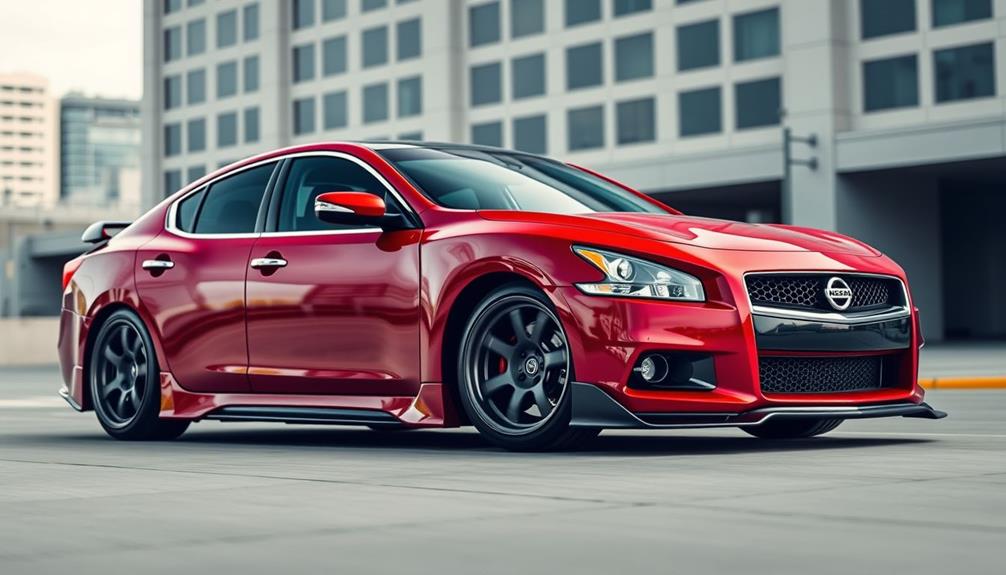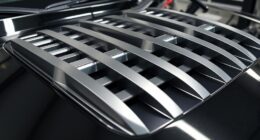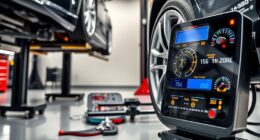Tuning your 2012 Nissan Rogue can boost both power and efficiency, making your compact SUV more enjoyable to drive. Start with a performance chip, like the Stage 1 option, which improves horsepower and fuel economy by up to 3 mpg. Consider adding a cold air intake to enhance airflow and increase responsiveness. Upgrading the exhaust system and lightweight rims can further optimize performance. Always keep in mind your transmission's limits to avoid potential issues. With careful selection of modifications, you can maximize your Rogue's capabilities and drive experience. There's plenty more to explore about tuning options available for you.
Key Takeaways
- Performance chips like Stage 1 or Stage 3 can significantly boost horsepower and improve fuel economy by up to 3 mpg.
- Installing a Cold Air Intake (CAI) optimizes airflow, enhancing engine efficiency and responsiveness for better performance.
- ECU remapping unlocks the full potential of the Rogue's 2.5L engine, increasing both horsepower and torque.
- Upgrading to lightweight racing rims improves handling and reduces unsprung weight, enhancing acceleration and overall driving dynamics.
- Consider safety and reliability when tuning, as modifications may impact factory warranty and vehicle performance under various conditions.
Performance Chip Options
When it comes to enhancing the performance of your 2012 Nissan Rogue, performance chips are a popular and effective option. These tuning devices can considerably boost horsepower and improve fuel economy, making them a smart choice for any owner looking to maximize their vehicle's capabilities.
You've got several options when it comes to performance chips. The Stage 1 Performance Chip Module OBD2, priced at $99.99, enhances engine performance without the need for modifications, making it a hassle-free choice.
If you want something more advanced, consider the Stage 3 Performance Chip OBDII Module, currently on sale for $229.95. It features an upgraded multi-core CPU for superior performance enhancements while ensuring a safe installation.
For those seeking thorough upgrades, the Stage 4 Performance Chip Module OBD2 is specifically designed for Nissan models from 2008 and newer and is available for $299.95. This option offers unique tuning logic and additional features for extensive performance improvements.
With user-friendly installations that you can complete at home, these performance chips provide immediate enhancements to your Nissan Rogue's power and efficiency.
Performance Enhancements Overview
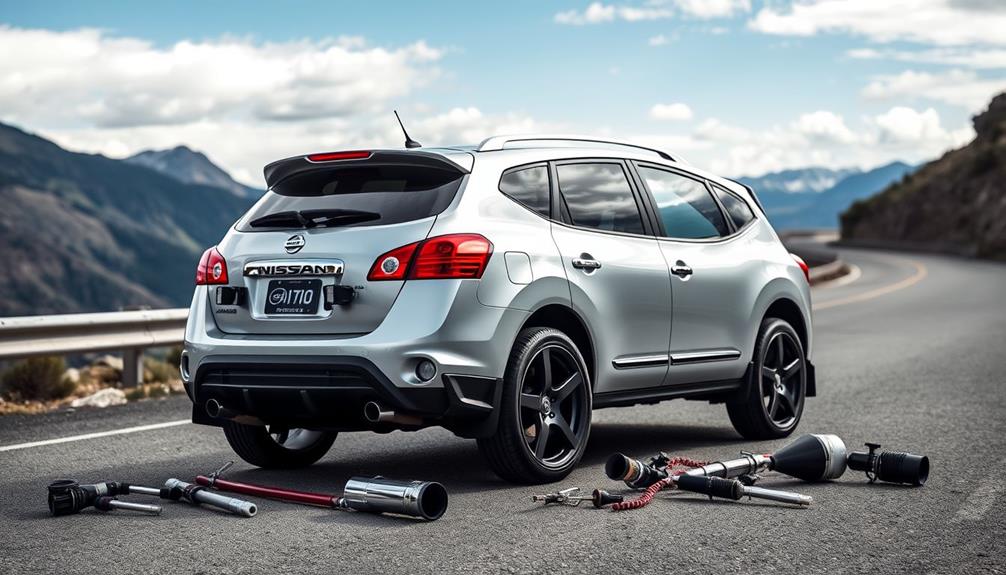
Enhancing your 2012 Nissan Rogue's performance involves several effective tuning options that can greatly improve driving dynamics. One of the most impactful methods is ECU remapping, which reveals the full potential of your four-cylinder engine, enhancing horsepower and torque for a more thrilling driving experience.
Coupling this with a performance chip can also lead to improved fuel economy—up to 3 mpg—while delivering better throttle feedback and responsiveness.
You'll find that the Rogue's 2.5L engine, producing 170 hp, responds well to performance tuning, making acceleration more enjoyable. If you're looking for significant gains, consider upgrading to a higher-performance stage chip, such as Stage 3 or Stage 4, which can dramatically enhance engine output and power delivery.
Additionally, integrating a Cold Air Intake (CAI) can optimize airflow, further boosting engine efficiency and performance.
Lightweight racing rims are another modification that can enhance handling. By focusing on these performance enhancements, you can elevate your Nissan Rogue's performance, transforming your compact SUV into a more dynamic and efficient vehicle on the road.
Safety and Reliability Concerns
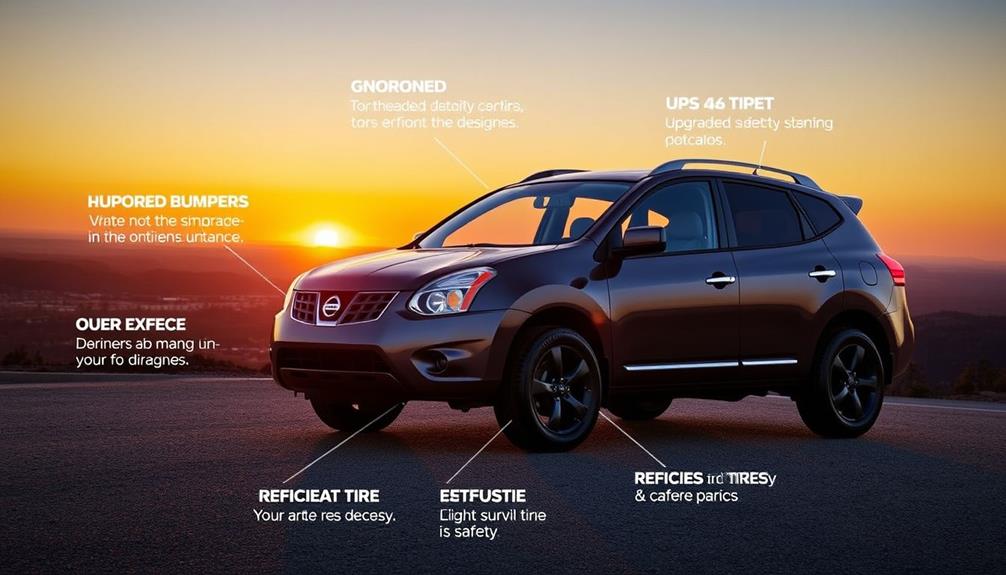
The 2012 Nissan Rogue's safety features are designed to instill confidence behind the wheel. With Nissan's Advanced Air Bag System (AABS), you get dual-stage front airbags and roof-mounted curtain airbags for enhanced protection.
Its strong crash test ratings—5 stars for side-impact safety and 4 stars for front and rollover impacts—underscore its reliability in potential collision scenarios.
Standard features like the Anti-lock Braking System (ABS) and Electronic Brake force Distribution (EBD) guarantee stable braking performance, no matter the driving conditions.
The Rogue's Vehicle Dynamic Control (VDC) boosts safety by adjusting engine power and applying brakes to individual wheels in slippery situations, giving you better control on the road.
However, if you're considering performance modifications, keep in mind that some changes may affect your factory warranty.
This can lead to concerns about long-term reliability and coverage, especially if you push the vehicle's performance limits.
Always weigh the benefits of tuning against potential ramifications on safety and warranty protections, making sure you maintain the balance between enhanced performance and the safety and reliability you expect from your Rogue.
Installation Process Explained
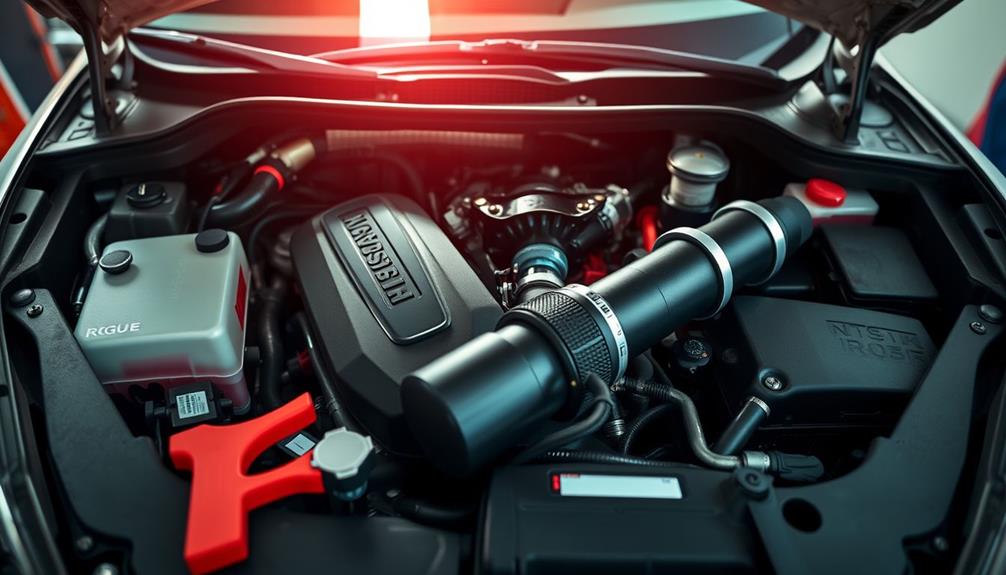
Installing performance chips in your 2012 Nissan Rogue is a straightforward process that most owners can tackle at home.
Most performance chips, such as the Stage 1 and Stage 3 modules, come with detailed instructions that guide you through the plug-n-play installation process. You won't need any advanced mechanical skills, cutting, or modifications—just a few simple steps to enhance your vehicle's performance.
To start, locate the OBD-II diagnostic port in your Rogue. This port is typically found under the dashboard near the driver's seat. Plug the performance chip into this port, guaranteeing a secure connection.
Once connected, the chip will work to optimize your engine's performance, potentially increasing horsepower and torque while improving efficiency.
After the installation, it's a good idea to monitor your engine's performance. Pay attention to throttle response and overall drivability, as you should notice immediate improvements.
Keeping track of these changes will help you gauge the effectiveness of your tuning modifications and guarantee your Nissan Rogue performs at its best.
With this simple installation, you'll maximize both power and efficiency in your compact SUV.
Engine and Transmission Compatibility
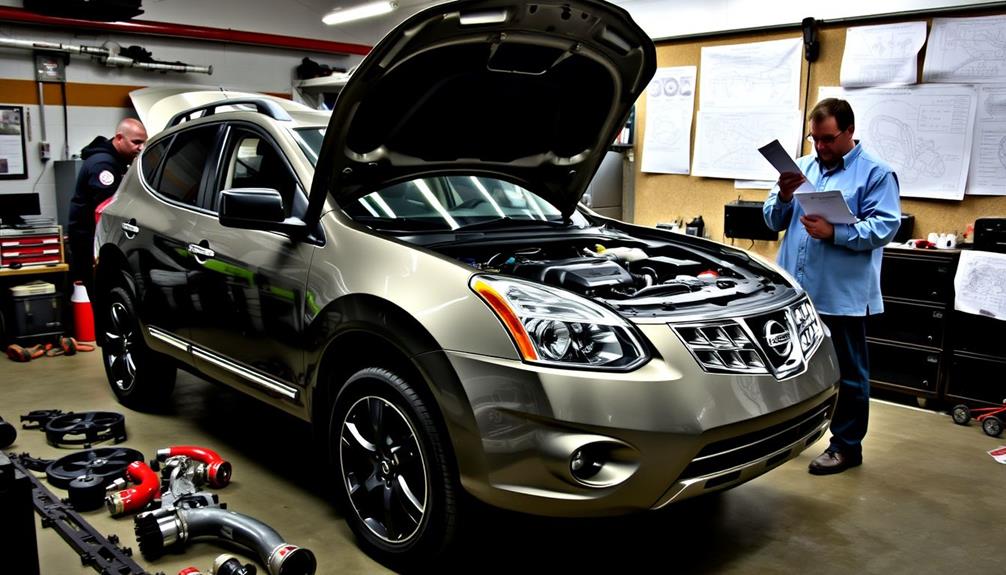
When tuning your 2012 Nissan Rogue, it's crucial to understand the engine and transmission compatibility.
While common modifications like cold air intakes can boost performance, you've got to keep the transmission's limitations in mind to avoid potential damage.
Knowing how your upgrades interact with the Jatco CVT will help you achieve the best results without compromising reliability.
Common Modifications for Rogue
For Nissan Rogue owners looking to enhance performance, several modifications can effectively improve engine and transmission compatibility. The Rogue typically features the QR25DE engine, and you can start by upgrading the airflow with a Cold Air Intake (CAI) or a Short Ram Intake (SRI). These options can help your engine breathe better, leading to noticeable gains in power.
Another significant performance modification is ECU remapping, which optimizes your engine's parameters to boost horsepower and torque, giving you a more responsive driving experience.
Keep in mind that while these improvements can enhance performance, the Jatco CVT transmission is designed to handle the stock engine output. If you push the limits too far, you might face issues like heat damage.
Additionally, consider upgrading to lightweight crank pulleys and flywheels to improve engine response. Just make sure these parts are compatible with your Rogue's daily driving dynamics.
Though the selection for performance tuning is limited compared to other models, with careful research and the right modifications, you can maximize both power and efficiency in your Nissan Rogue.
Transmission Limitations Explained
Understanding the transmission limitations of your Nissan Rogue is vital if you're planning to push its performance boundaries. The Rogue typically features the QR25DE engine, which can produce significant horsepower gains through performance upgrades.
However, the Jatco CVT transmission has a rated capacity of only 200HP, making it important to evaluate how much power you're adding. As you increase engine output, you risk running into common transmission issues. The CVT is known to approach its maximum torque threshold, leading to potential heat damage, clutch pack failure, and torque converter problems if you exceed its design limits.
While modifications like a Stage 2 or Stage 3 clutch can help manage increased torque, they're mainly applicable to models with manual transmissions like the SE-R Spec V. If you decide to use lightweight crank pulleys or flywheels, be cautious. They might improve performance but could adversely affect daily driving and strain the transmission.
Ultimately, balancing performance upgrades with the transmission's capabilities is key to maximizing your Nissan Rogue's potential without compromising reliability.
Performance Modifications Recommendations

To access the full potential of your Nissan Rogue, consider a range of performance modifications that can elevate your driving experience.
Start with a performance chip, like the Stage 1 OBD2 module, which can boost your Rogue's horsepower and torque while potentially improving fuel economy by up to 3 mpg.
Next, enhance engine airflow with Cold Air Intake (CAI) or Short Ram Intake (SRI) modifications. These upgrades greatly increase power output and responsiveness, making your SUV feel more alive.
Pair this with an upgraded exhaust system to improve exhaust flow, which not only enhances engine efficiency but also delivers a more aggressive sound.
Don't overlook the importance of your brake system. Upgrading to high-performance brake pads and rotors can provide better stopping power and overall safety, especially when combined with your newfound power.
Finally, consider lightweight racing rims. They reduce unsprung weight, improve handling, and enhance acceleration, making your Rogue more agile on the road.
With these performance modifications, you'll enjoy a more powerful, efficient, and thrilling driving experience in your Nissan Rogue.
Community Insights and Feedback

Numerous Nissan Rogue owners actively share their tuning experiences in online forums, creating a vibrant community focused on performance modifications.
You'll find countless discussions about performance tuning, especially regarding the QR25DE engine. Enthusiasts often recommend common modifications like cold air intakes and ECU remapping to maximize horsepower and torque.
However, feedback is mixed when it comes to certain aftermarket parts. While lightweight flywheels and underdriven pulleys are frequently praised, members emphasize the importance of thorough research before making purchases.
Some mods, like camshaft upgrades, receive a warm welcome, while others may not deliver the expected performance gains, facing criticism from the community.
It's also worth noting that many Nissan Rogue owners suggest exploring related forums, such as those for the Altima, to gather valuable community insights and alternative ideas for engine modifications.
This approach can help you navigate the limited aftermarket support available for the Rogue. Overall, engaging with fellow enthusiasts can guide you towards successful upgrades and help you avoid ineffective investments in your quest for improved performance.
Brake System and Tire Upgrades
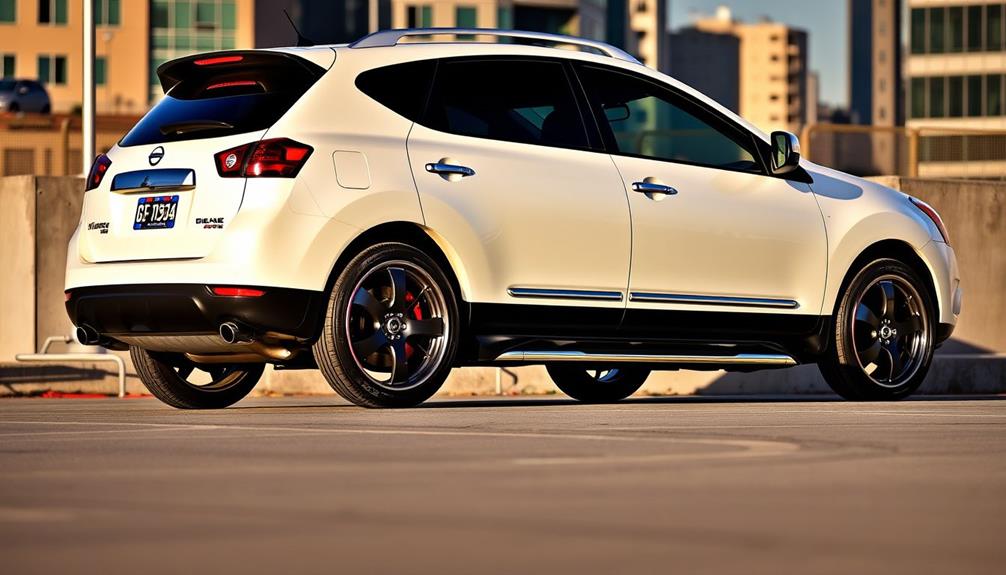
Upgrading your Nissan Rogue's brake system and tires can greatly enhance your driving experience. The factory-installed disc brakes provide a solid foundation, but you can improve braking performance further by installing high-quality brake pads and rotors. This upgrade considerably reduces stopping distances and makes your vehicle more responsive during emergencies, boosting your safety on the road.
When it comes to tires, proper tire selection is essential. Choosing the right tread patterns can enhance traction and ride quality, especially in various weather conditions.
You might also consider lightweight alloy rims, which not only add a sleek look but also reduce unsprung weight. This change improves handling and can even enhance fuel efficiency.
Keep in mind that tire size modifications can impact your Rogue's performance. While smaller tires may slightly improve fuel economy, they can lead to reduced speedometer accuracy and altered handling characteristics.
Striking the right balance between aesthetics and functionality is key to maximizing your vehicle's overall performance. By focusing on these brake system and tire upgrades, you'll experience a noticeable improvement in both driving dynamics and safety.
Market Trends in Performance Tuning

As a Nissan Rogue owner, you might've noticed a growing trend in performance tuning that emphasizes not just power but also fuel efficiency.
The market is evolving, with more enthusiasts seeking modifications that enhance their driving experience while keeping operational costs in check.
Here are some key trends shaping performance tuning for compact SUVs like yours:
- Aftermarket performance chips: These user-friendly, plug-n-play options allow you to boost horsepower and torque, potentially improving fuel efficiency by up to 3 mpg.
- Balancing act: There's a noticeable shift toward tuning solutions that deliver both performance gains and better fuel economy, aligning with consumer demands for efficiency.
- Community feedback: Owners are actively sharing their experiences with various tuning solutions, fostering an environment where you can explore different options despite limited aftermarket parts for the Rogue.
Maximizing Fuel Efficiency
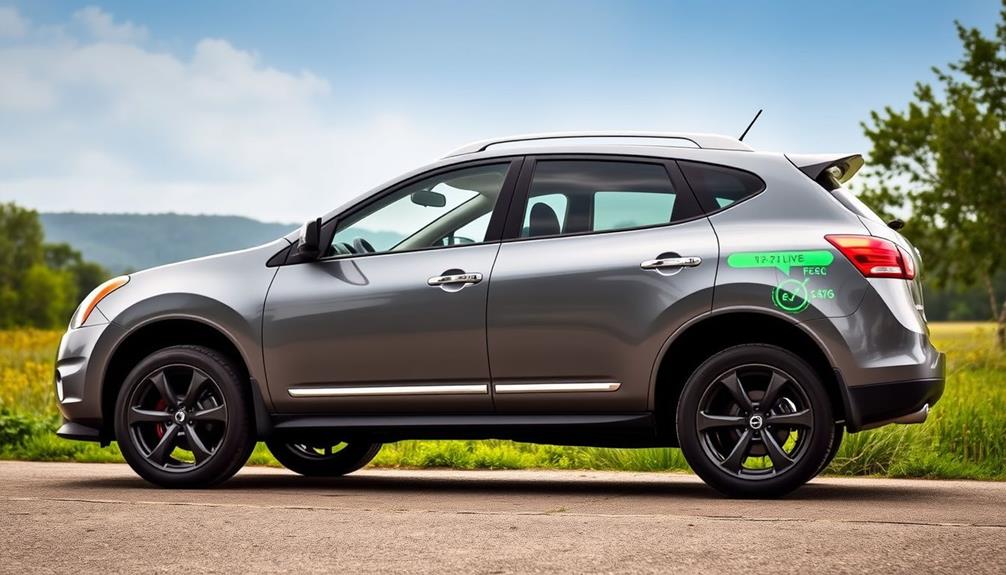
Maximizing fuel efficiency in your 2012 Nissan Rogue can make a considerable difference in your driving experience and budget. With an EPA-estimated fuel economy of 23 mpg city and 28 mpg highway, there are several ways to enhance this further.
One effective method is to install a performance chip, which can potentially boost your fuel economy by up to 3 mpg while also improving overall engine performance.
Regular maintenance is essential too. Keeping your tires properly inflated and changing your oil on time can greatly maintain ideal fuel efficiency.
Don't overlook lightweight components—upgrading to racing rims can reduce your vehicle's weight, leading to better acceleration and improved fuel economy.
Additionally, consider upgrading to a cold air intake system. This enhancement allows for better airflow to the engine, promoting more efficient combustion and further increasing your fuel economy.
Frequently Asked Questions
Why Does My Nissan Rogue Feel Sluggish When Accelerating?
If your vehicle feels sluggish when accelerating, check the air filter, fuel quality, and spark plugs. A dirty filter or low-quality fuel can limit performance, while worn plugs hinder combustion efficiency, affecting overall acceleration.
What Does Sport Mode Do on My Nissan Rogue?
Oh, you thought your SUV was just a couch on wheels? Engage Sport Mode and feel it transform! It boosts throttle response, shifts higher RPMs, and gives you that thrilling acceleration you never knew you needed.
How Many Miles Will a 2012 Nissan Rogue Last?
Your 2012 Nissan Rogue can last between 150,000 to 200,000 miles with proper care. Many owners report exceeding 200,000 miles, emphasizing the importance of regular maintenance and addressing any mechanical issues promptly.
Which Nissan Rogue Gets the Best Gas Mileage?
When it comes to sipping fuel like a fine wine, the front-wheel drive Nissan Rogue models shine brightest. They often outpace their all-wheel drive siblings, delivering the best gas mileage while still offering solid performance.
Conclusion
To sum up, tuning your 2012 Nissan Rogue can greatly boost both power and efficiency, transforming your compact SUV into a performance machine. Did you know that some tuning enthusiasts have reported up to a 20% increase in horsepower and a similar improvement in fuel efficiency? Just imagine feeling that extra power on the open road while saving money at the pump. With the right upgrades, you can truly maximize your Rogue's potential and enjoy every drive even more.



